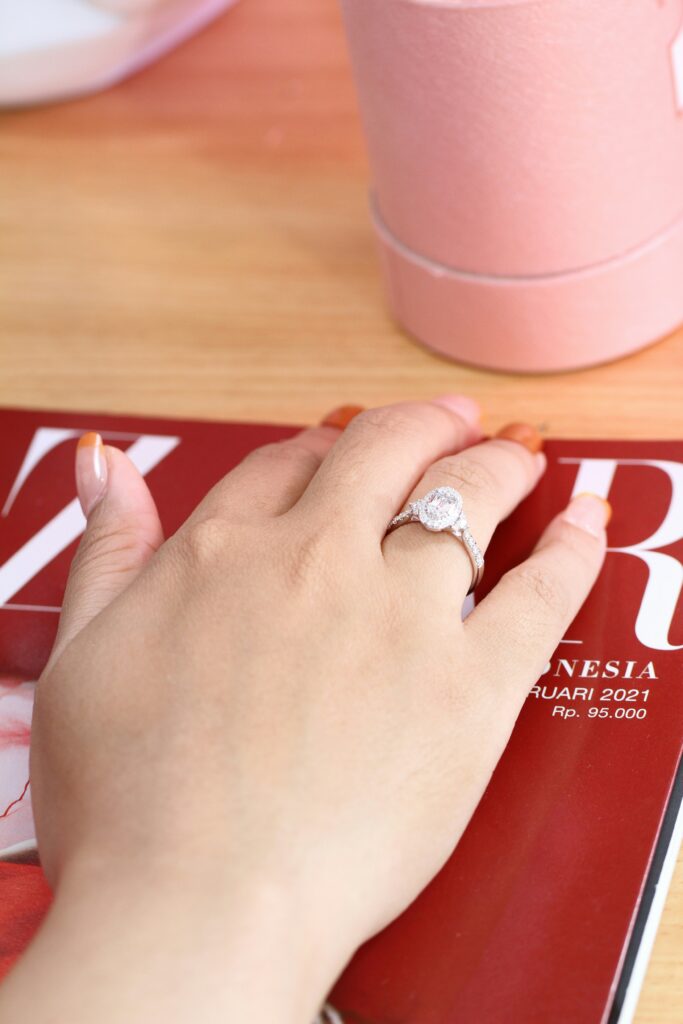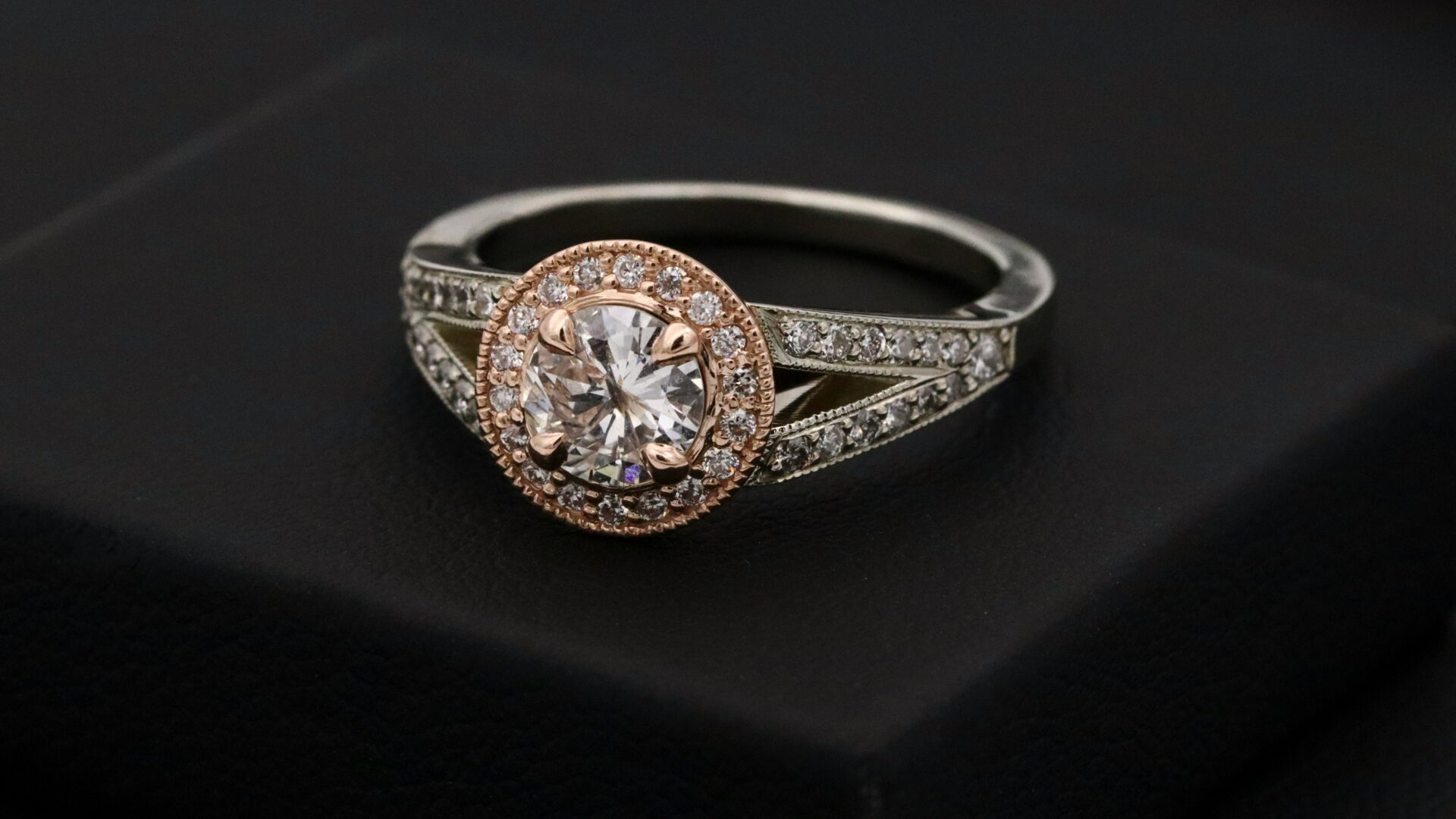That white gold ring or necklace you adore might not always stay that perfectly cool, bright white. Over time, you might start to notice a hint of yellow appearing. Does white gold tarnish? Well, not in the way silver does, but that subtle color shift is definitely noticeable.
This blog dives into the reasons behind that yellowing and, more importantly, what you can do about it.
What Is White Gold and How Is It Made?
Understanding the reason behind white gold turning yellow helps to know what it is in the first place. Unlike the rich yellow of naturally occurring gold, white gold isn’t a single metal. It’s actually an alloy, a mix of pure yellow gold with other white metals. Think of it like a recipe! Jewellers often use metals like nickel, palladium, or silver to create this alloy. These metals contribute to the final colour and affect the metal’s overall durability.
The amount of pure gold in the mix is measured in karats. So, an 18k white gold piece contains 75% pure gold, whereas 14k white gold has about 58.3%. The higher the karat, the softer the gold will be and the more likely that the underlying yellow hue will eventually peek through. Since pure gold is too soft for jewellery to withstand daily wear, these other metals make it tougher and more practical.
Even with those “white” additions, the resulting metal isn’t quite the bright white we associate with white gold jewellery. That super shiny look comes from a final touch: a coating of rhodium. Rhodium is a highly reflective, hard metal that belongs to the Platinum family.

Why Does White Gold Turn Yellow?
That subtle yellow tinge isn’t technically tarnish, but it’s a totally normal process to be aware of. So what’s behind it? Here’s the breakdown:
- Natural Wearing of Rhodium Plating: Think of rhodium plating as a temporary shield. It’s the dazzling surface we see, but it is not permanent. Over time, this thin layer wears away from everyday wear and tear: the friction from wearing it, banging it on things or even just using lotions, soaps, and other common chemicals all contribute.
- Exposure to Everyday Elements: Certain everyday things tend to hasten the breakdown of rhodium. Perspiration, surprisingly, is one culprit. The acids in our sweat can erode the finish. The same goes for your favourite perfume or cosmetics. And keep your jewellery far away from chlorine, found in swimming pools and cleaning supplies. This chemical is especially aggressive and will dissolve rhodium quickly.
- Time and Maintenance Frequency: Here’s the thing to remember about white gold: that underlying yellow tone is part of its nature. It’s not a flaw, and it definitely doesn’t mean your jewellery is ruined. It simply means the base metal is starting to show. Regular re-plating is just a necessary part of maintaining that bright white look. Plan to start thinking about maintenance every 12-18 months, depending on how often you wear the piece.
How to Fix a White Gold Ring That’s Turning Yellow
Okay, so your white gold yellowing is not a big issue. Don’t panic! Here’s how to bring back the shine:
- Professional Rhodium Re-Plating: This is the go-to solution for refreshing white gold. A jeweller will thoroughly clean your jewellery, removing any dirt or oils. Then, they’ll apply a fresh coat of rhodium, often using an electric current to ensure even plating. Expect to pay somewhere in the range of $80 – $200 CAD for this service, though the actual cost will depend on the size and complexity of the piece. Remember, this isn’t a forever fix; you’ll need to repeat the process periodically. Aim for every 12-18 months, depending on how often you wear it.
- Polishing and Cleaning Before Re-Plating: Think of it like prepping a wall before painting. To ensure the new rhodium adheres properly, the surface needs to be spotless. Jewellers will remove any existing dirt, oils, or residue.
- At-Home Care Tips to Slow Down Yellowing: Taking care of your jewellery at home can definitely extend the life of the rhodium plating.
- Gentle Cleaning: Use a mild soap, warm water, and a super-soft brush to clean your white gold regularly. Avoid harsh chemicals.
- Soft Cloth: Always dry your jewellery with a lint-free cloth to prevent scratching.
- Avoiding Chemicals: Remove your white gold rings before handling any chemicals, whether it’s household cleaners or chlorine at the pool.
- Proper Storage: Store each piece of jewellery separately in a soft pouch or a lined box to avoid scratches.
Can You Change White Gold to Yellow Gold?
Curious about switching things up? Here’s what’s possible when it comes to changing the colour of your white gold jewellery.
- The Possibilities and Limitations: Unfortunately, you can’t simply melt the white gold down and magically transform it back into yellow gold. But you can definitely change its appearance.
- Re-Plating Options: From White to Yellow or Rose Gold: Instead of rhodium, you can have your white gold plated with yellow gold or even rose gold. Keep in mind that this new plating, just like rhodium, will eventually wear off.
- When Redesigning Might Be Better Than Re-Plating: If you’re craving a more permanent change, think about completely redesigning the piece. Consider remounting the stones into a yellow gold setting, giving it a whole new look.
How to Keep White Gold Looking Brilliant
Prevention is always the best medicine! Here are a few simple habits to keep your white gold dazzling:
- Routine Professional Maintenance: Take your white gold jewellery to a jeweller for an annual checkup. They can inspect the prongs, polish the metal, and advise you on whether it’s time for re-plating.
- Everyday Protection Tips: Everyday wear and tear can be avoided by;
- Remove rings before cleaning: Cleaning products are harsh on metals.
- Remove rings before swimming: Chlorinated water can damage plating.
- Remove rings before applying creams: Lotions and creams can dull the shine.
- Safe Storage Practices: Scratches can dull the shine of your jewellery, so follow these rules:
- Use soft pouches: Avoid scratches by keeping each piece separate.
- Separate compartments: Line the pouches with a soft material for added protection.
What are the Common Myths About White Gold
Let’s clear up some common confusion surrounding white gold:
- “White Gold Doesn’t Contain Real Gold” — False: White gold is definitely made with real gold! The karat marking indicates the percentage of pure gold in the alloy.
- “Yellowing Means the Ring Is Fake” — False: Yellowing is a normal occurrence, not a sign of fake jewellery.
- “Rhodium Plating Damages Jewellery” — False: When done correctly by experienced professionals, rhodium plating actually protects the jewellery.
Key Takeaways
- The rhodium plating on white gold wears down over time.
- Re-plating will bring back that bright whiteness.
- Proper cleaning and storage help prevent damage.
- Redesigning can create long-term transformation for yellowing pieces.

